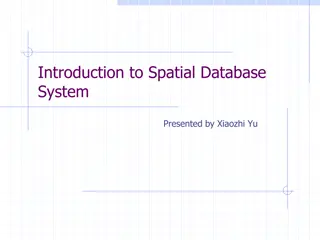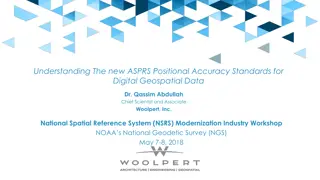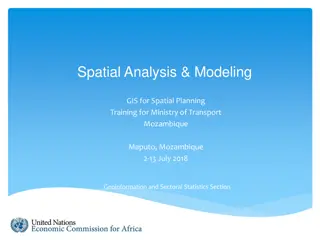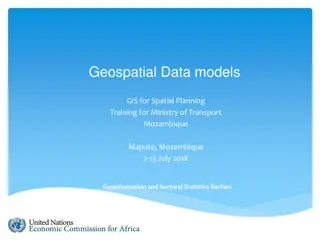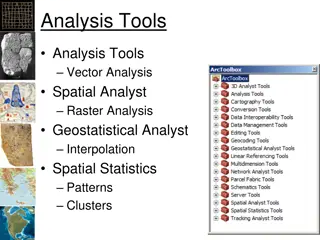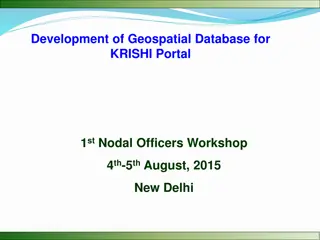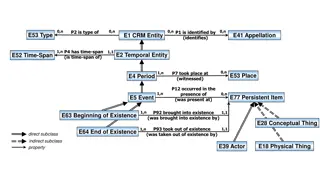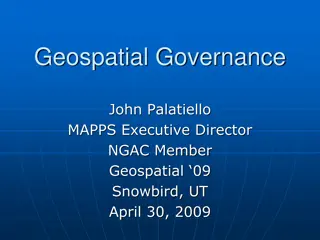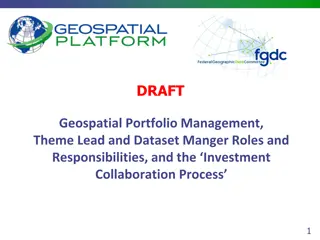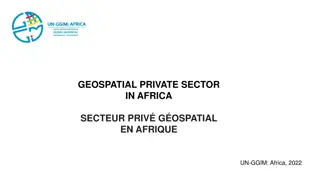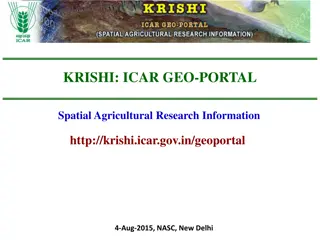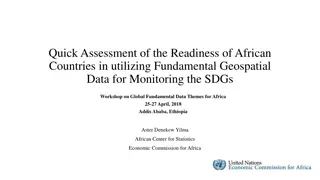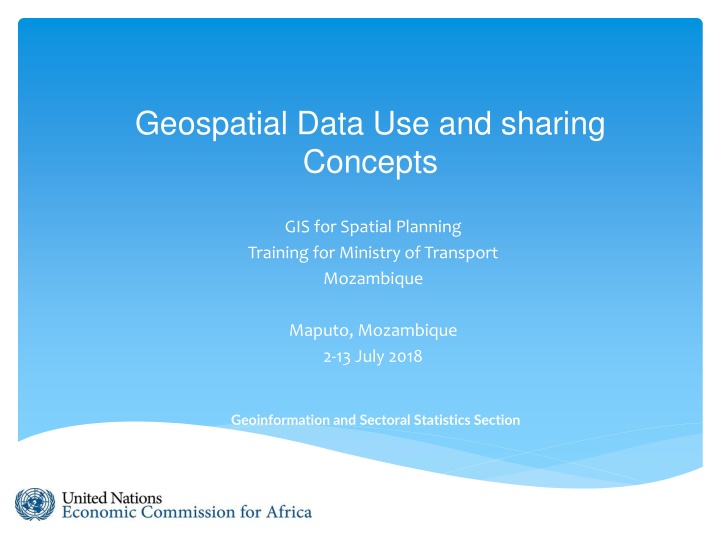
Geospatial Data Use and Sharing Concepts for Spatial Planning Training
The training session focuses on geospatial data use and sharing concepts, highlighting challenges in data volume, duplication of efforts, and the importance of spatial data infrastructure. It explores the evolution of Spatial Data Infrastructure (SDI) and the initiatives to facilitate efficient information services through data sharing.
Download Presentation

Please find below an Image/Link to download the presentation.
The content on the website is provided AS IS for your information and personal use only. It may not be sold, licensed, or shared on other websites without obtaining consent from the author. If you encounter any issues during the download, it is possible that the publisher has removed the file from their server.
You are allowed to download the files provided on this website for personal or commercial use, subject to the condition that they are used lawfully. All files are the property of their respective owners.
The content on the website is provided AS IS for your information and personal use only. It may not be sold, licensed, or shared on other websites without obtaining consent from the author.
E N D
Presentation Transcript
Geospatial Data Use and sharing Concepts GIS for Spatial Planning Training for Ministry of Transport Mozambique Maputo, Mozambique 2-13 July 2018 Geoinformation and Sectoral Statistics Section
Data Sharing Concepts The volume of data is challenge with geographic information systems With the increasing data acquisition methods in modern technologies: remote sensing and GPS large and valuable datasets are available Datasets are available in many institutions / organization Others duplicate the effort to create the datasets that already exist with out knowing the existence of the datasets or with lack of access and data sharing mechanisms
Data Sharing Concepts Organizations understood the problems related with geospatial data/information such as: duplication of efforts, non-standardized approaches, lack of awareness, Geo-information providers have realized that satisfying geo- information needs goes beyond the capacity of single organizations In recent years, technological developments have facilitated access to geo-information and made it easier to exploit it effectively
Data Sharing Concepts Organizations were seeking for mechanisms that enable them to work together to share their data and resources and to provide efficient information services to the users Brought different data sharing initiatives Globally recognized concept/initiative of spatial data infrastructure (SDI)
Spatial Data Infrastructure Spatial Data Infrastructure (SDI) evolved since early ninties: got recognition when development of national geospatial data infrastructure in Canada has received acceptance from the public, private sector and the user community, The first international conference on Emerging Global Geospatial Data Infrastructure held in Bonn in September, 1996 to share ideas in building global geospatial data infrastructure among the international communities Global Geospatial Data Infrastructure (GSDI) Association has members from Governments, Private, Academia, user community GSDI conference held almost every year which gathers the geospatial community from all around the world.
Spatial Data Infrastructure Spatial Infrastructure standards, mechanisms necessary to facilitate sharing, access to, and responsible use of geospatial data Data Infrastructure ) is human (Geospatial Data the technology, resources, policies, related and
Spatial Data Infrastructure Currently, SDI is being implemented at different levels: national, regional and global levels to facilitate the discovery, and access to geospatial data and services National Spatial Data encompasses the policies and technology used and the institutional arrangement within a nation to produce, manage, and information Infrastructure (NSDI) share geospatial
Spatial Data Infrastructure Geopspatial Metadata Metadata is data about data. Geospatial metadata: the information that describes geospatial data, geospatial Web services, or other geospatial resources. Metadata provides the user information about the data such as content, source, quality, condition for use, lineage (history of use and changes) and other relevant characteristics
Spatial Data Infrastructure Used for evaluating the fitness of the datasets: Who collected the data? Is the source of data a recognized authority? What were the methods used to acquire the data? For what purpose were the data collected/intended? What time period does the data represent? Completeness of the data, etc.
Spatial Data Infrastructure Clearinghouses Clearinghouse is a system of software and institutions to facilitate the discovery, evaluation and downloading of digital geospatial data . A clearinghouse consists of a number of servers that contain information about available digital geospatial data, the metadata
Spatial Data Infrastructure Geospatial Web Services Geospatial Web services provide access to spatial data and GIS functionalities through the Internet Web services are based on simple and proprietary standards, that makes data exchange possible, regardless of location, processing platforms, operating systems, or languages; lowering the cost of data sharing Makes it for users to integrate them with their own systems and applications with out the need to install special type of GIS software
Spatial Data Infrastructure Geoportals A Web portal is a Web site that functions as an entry point to the World Wide Web A geoportal is a web portal specifically for geospatial information; a gateway to a collection of online geospatial information resources A single point of access to geospatial data, geospatial web services, and other geospatial resources Facilitate geospatial information sharing between providers, and the users
Spatial Data Infrastructure Geospatial data/information providers publish the metadata to the geoportal. Users can browse or search through geoportals to find relevant geospatial resources. Once they find and evaluate their applicability, users can download the online data, or connect to and use Web services, or Contact the content provider for offline data or document delivery
Spatial Data Infrastructure As the broker between the data provider and the user, geoportals are serving as the face of SDI Because geoportals help to realize the objectives of SDI to facilitate collaboration, they have been developed as a major part of SDI A very good example of Geospatial portal is INSPIRE European SDI
Spatial Data Infrastructure Spatial Data Infrastructure Initiatives in Africa UNECA has been promoting SDI both at national and regional levels It has mainly been doing awareness raising and support the efforts of countries in realizing their national SDI A number of African countries have been making efforts to mainstream geospatial information in their national development strategies through the development of NSDI and geospatial and space programmes Other programs in open data initiatives are ongoing Mozambique is one of the countries in the effort to realize open data initiatives; (mozambique.opendataforafrica.org/ ) the open data portal
THANK YOU! denekewa@Un.org


